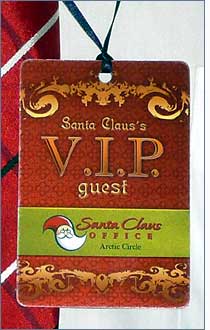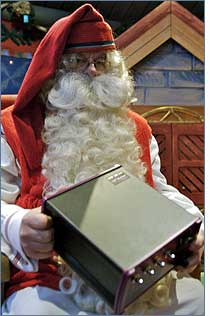In the Arctic Circle, at a site located more than 800 kilometers north of Helsinki, Santa Claus is using radio frequency identification to manage his office and the thousands of pictures his elves take each day. Santa Claus Office has been operating near Rovaniemi, Finland, since 1992, and this year moved to a new building. As part of those changes, St. Nick and his helpers implemented an RFID system to improve sales of photos of himself with his fans, and to manage visitors’ personal information.
The facility is open every day of the year. During the high season, between November and March, some 500,000 people visit the office and other attractions in the village, which has been a tourist hub for decades. Among these attractions is Finland’s largest post office (Santa gets a lot of mail).
Entry into Santa’s office is free. Individuals and groups can register at the front desk and receive a plastic souvenir card, about the size of a business card, which hangs by a ribbon around a person’s neck. At this point, a multilingual elf collects information on whether Laura has been naughty or nice, and what Wolfgang wants for Christmas. This data is then stored in middleware and linked to the unique ID contained in the EPC Gen 2 UHF RFID tag visitors attach to their cards.
Three RFID-enabled printers are set up in the entryway. Visitors serve themselves at the printers, taking an adhesive label already separated from its backing and sticking it on the back of the souvenir card. Initially, visitors were given an RFID label that slipped into a plastic sleeve on the card’s back, but the system designers switched to adhesive labels to keep costs down. The goal was to deploy a system employing an RFID tag that costs less than 15 euro cents ($0.22) and allows visitors to decline the tag if they choose. Visitors are informed about the tags before entering.
In the entranceway to Santa’s office, an RFID interrogator reads the card’s tag for the first time. The information collected allows security officials to ensure a steady flow of visitors, without overcrowding. Visitors browse through Santa’s library and other rooms, then move on to one of two offices at a predetermined appointment time, printed on the RFID label. (Two Santas work simultaneously to fulfill as many wishes as possible.)
Each office is outfitted with an RFID portal reader and antennas to interrogate the tags of incoming visitors. Once a party enters the room, data provided voluntarily about each visitor pops up on a screen inside a big golden book that Santa keeps on his lap. In this way, he knows if Cynthia brushed her teeth this morning, or if Paul was a good boy, allowing St. Nick to personalize the experience for the children. A camera system installed in the room is in sync with the RFID reader, so photographs and videos are taken automatically and linked to the unique ID on each card via a timestamp.
After youngsters finish telling the old man their secrets, they have the option of buying photographs and videos of the experience. Before the RFID system was implemented, all pictures were printed and placed on a wall, and visitors identified their own photos among the rest. Now, they can proceed to a wooden counter with a computer screen resting on it and an RFID interrogator installed beneath. As a visitor approaches the counter, its interrogator reads that person’s tag, causing any corresponding pictures and videos to automatically pop up on the screen.
The new system allows Santa’s office to sell videos as well as photos—which can be ordered on the spot—and helps visitors quickly find images and, if they prefer, keep them private. Elves who used to spend their days sorting pictures now have more time to help Kris Kringle shovel snow or feed his reindeer.

The RFID system was the brainchild of Finnish imaging and video company Helrot. The firm met German RFID systems developer and integrator Microplex Printware at the CeBIT trade fair this spring, and the two decided to implement the solution together. Designed by Microplex, the system uses UPM Raflatac tags conforming to EPCglobal‘s Class 1 Gen 2 standard, as well as RFID interrogators from Italian supplier CAEN RFID. Microplex provided the middleware.
As Microplex was putting the system together, it needed to add an additional reader antenna to one gate to Santa’s office because his decorations, covered in gold metallic paint, caused radio interference, impeding tag reads. “The third antenna scans at a different time than the first two,” says Frank Gaertner, a project manager for RFID solutions at Microplex. The additional antenna, and the tuning and timing of the antennas, helped resolve such interference.
Read rates average between 95 and 100 percent, Gaertner says, depending on visitors’ behavior. If they stand too close to one another or hold their hands over their cards, an interrogation may fail. “In logistics, a 95 percent read rate is not acceptable,” he notes, “but for Santa, it’s OK.” The system was set up in mid-November. After testing, Santa formally accepted it in mid-December—just in time for throngs of holiday visitors to his snow-bedecked office.


